#Otodus megalodon
Explore tagged Tumblr posts
Text

Livyatan has always appeared way, way scarier to me than Megalodon. In the case of the latter, I see an oversized shark. In the former, I essentially see the sperm whale version of a probably psychotic wild boar biker gang member ready for a rampage, which in this case means swimming off to fuck up the Meg as a break from snacking on your cousins.
#natural history#marine animals#marine life#palentology#livyatan#livyatan melvillei#megalodon#otodus megalodon#random thoughts
34 notes
·
View notes
Text

A tooth of the largest fish to ever live, Otodus megalodon. This fossil is somewhere between 23 and 3.6 million years old, and is the first real fossil I have ever obtained. In life, one animal would have 276 of these teeth, many of which would be larger than this one.
This individual tooth is only about 2.5 inches (7 centimeters) long, making it slightly smaller than the 3-5 inch average. However, some megalodon teeth reached over 7 inches. Of course, a tooth that size would cost a fortune, which is why the one I have is relatively tiny.
#scavenger’s purchases#animal teeth#sharks#megalodon#otodus megalodon#shark teeth#fossils#vulture culture
3 notes
·
View notes
Text
I used to volunteer at a science museum and once we had a fossil exhibit (FINALLY! said my little paleo-teen self) and my favorite job was, of course, sitting at a table with fossils and reproduction fossils, talking about them to passersby.
We had a repro O. megalodon tooth, and the binder that trained us on our Fossil Facts told us how long the living shark would have been. Because everyone asks. The estimate they had at the time was something like 54 feet. (I know, they say longer now!) Anyway, adults always responded to this number with eyebrows up, and kids…did not absorb this fact. Their mouths stayed open because they were looking at the tooth, but they did not take it in. So I went home and searched on the internet (yes, we had to go home to do that, I’m old.) for the size of a yellow school bus (I’m also American), which seemed to be about 45 feet. So the next time a kid asked how big the shark was, I leaned in and said “It was 54 feet long.” (Parent’s eyebrows go up.) “That’s bigger than your school bus.” Screaming! Carrying on! Grabbing other kids to see the tooth! Highly satisfactory.
Anyway, if you live somewhere where kids go to school or field trips in a big school bus, highly recommend storing this Megalodon fact in your head to amaze the kiddos. It’s not just that it’s a size they can comprehend: it’s that they are automatically imagining themselves inside. 🦈
One of my favourite parts of working with kids is like… Very Gently subverting their idea of gendered topics… Like if a girl goes ‘no, sharks are a boy thing’ and you go “UM ACTUALLY THATS STUPID AND INCORRECT” they get freaked out, but if instead u go “Are you sure? Cause I think sharks are awesome, here’s a scale picture of a Megalodon” it’ll blow their tiny mind and they’ll be shitting themselves over it for days. 100% effective, 10/10 recommend
#paleontology#science communication#talking to kids#units of measurement#Otodus megalodon#shark#healthy scare
105K notes
·
View notes
Text

A piece from the #MonkeyCruise series, in which I take classic pieces from art history and replace humans with extinct primates and alter the scenes accordingly.
Here it's Mesopithecus witnessing a beached Otodus megalodon.
#sciart#paleoart#paleostream#palaeoblr#otodus#megalodon#monkeycruise#mesopithecus#primate#art history
1K notes
·
View notes
Text
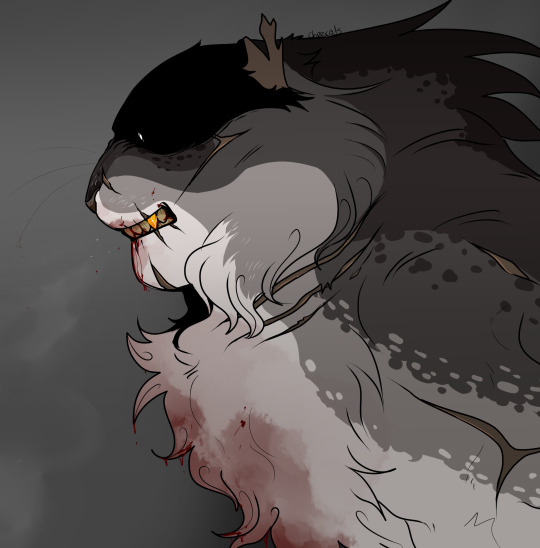
Last thing you see after hurting one of her awful little brats that 100% deserved it
#// blood#cheez rambles#cheez design#my art#original character#warriors oc#By Sand By Sea#The Megalodon#Captain Otodus#The Divers#// she's reasonable to a degree but she still got that mama bear instinct#// love accentuating how big and strong she is- they dont know this woman intelligent and cunning asffff
140 notes
·
View notes
Text




My 25 years of palaeoart chronology...
In 2010 I painted a Miocene scene staring Otodus megalodon. Unfortunately, I've lost the names of the other illustrated species, but there is a smaller shark species, a small toothed whale, and an early baleen whale.
#Art#Painting#PaleoArt#PalaeoArt#SciArt#SciComm#DigitalArt#Illustration#Dinosaurs#Birds#Reptiles#Palaeontology#Paleontology#Sharks#Otodus#Megalodon#JurassicWorld
76 notes
·
View notes
Text
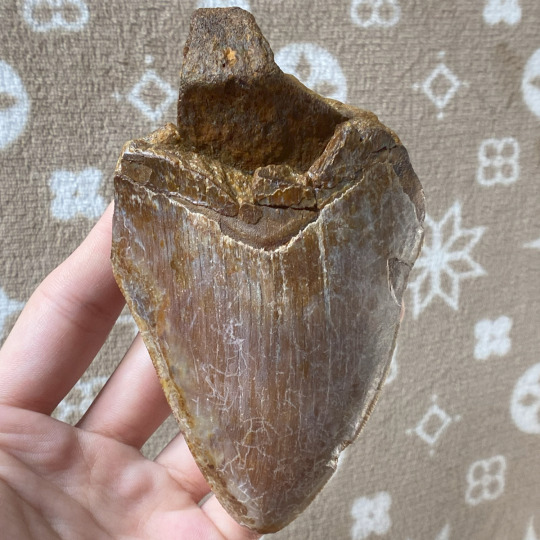
A fossilized shark tooth of an Otodus megalodon from the Luanda Formation in Cacuaco, Luanda, Angola. The teeth from these famous otodontid sharks can be found in Miocene to Pliocene aged deposits throughout the world. What is unusual about this tooth is the locale, though unfortunately, most of the root is missing and there is significant damage to the blade itself. The blade by itself has a slant height of around 3.5 inches. This old collection specimen like many other fossilized Angolan shark teeth was collected by a geologist working in the region decades ago.
#fish#shark#chondrichthyan#fossils#paleontology#palaeontology#paleo#palaeo#otodus#carcharocles#miocene#megalodon#cenozoic#prehistoric#science#paleoblr#fossil friday#fossilfriday#オトドゥス#カルカロクレス#オトドゥス科#メガロドン#サメ#化石#古生物学
14 notes
·
View notes
Text
Extinct?Faunus Jaune
Idea is courtesy of @unknowdude34
---------------------------------------------------
Kasai Rex!Faunus Jaune
Jaune: I'll see you guys later.
Ruby: Huh? Where are you going?
Jaune: I'm gonna go eat in my room.
Nora: We can do that?
Weiss: Sit down and eat, you antisocial buffoon!
Jaune: ...Okay.
Cardin: I'm telling you, I know what I saw! There was something by the pool last night, tearing apart something huge!
Russel: Cardin, I normally believe ya, but it just sounds too weird.
Dove: Yeah, like, a deer carcass in the pool? Pretty sure we'd get an announcement about that.
Lark: Not to mention the crocodile you saw eating it.
Cardin: That wasn't a crocodile! It was... It was something else! Something out of a horror film!
Jaune: (Cutting off the legs on his nuggies, Wishing he could eat in private)
Fun Fact! In 1933, in the African Kasai Valley, a hunter named John Johnson took a photo of an alleged dinosaur while hunting elephants. The elephants he intended to shoot were in fact hunted by a bipedal creature with red scales and black stripes. He shot this creature, but it retreated. On his return to camp, he found the creature again eating a rhinoceros near the water.
~~~~~~~~~~~~~~~~~~~~~~~~~~~~~~~~~~~~~~~~~
Percetus Colossus!Faunus Jaune
Nora: WOW! You are HUGE!
Jaune: Um, h-hi... I'm Jaune.
Nora: Where were you on the bullhead?! How'd you even fit?!
Ren: Nora, please.
Jaune: They, uh... They had to call in another bullhead for me.
Fun Fact! A recently discovered early whale, the basilosaurid Perucetus Colossus has the heaviest animal bone mass to have ever been discovered, even outsizing the giant Blue Whale.
---------------------------------------------------
Sperm Whale!Faunus Jaune Arc & Shark!Faunus Yang Xiao Long & Leviathan Melvillei!Faunus Papa Arc & Otodus Megalodon!Faunus Raven Branwen
Jaune: Just you and me, Yang.
Yang: Yeah... Only one of us can be the top fighter in this ring, and it's gonna be me.
Pyrrha: Why are those two always fighting?
Blake: For as long as I've known Yang, she and Jaune have always been fighting. It might even date back to their ancestors.
Meanwhile...
Papa Arc: Make the first move, Branwen...
Raven: Hmph! Ladies first, Arc...
Fun Fact! Leviathan Melvillei is an ancient ancestor of the sperm whale, equipped with teeth on it's top AND bottom jaw. It is argued whether it hunted Megalodon, were hunted by it, or simply competed would attack the other given the opportunity. The third is the often agreed upon consensus.
---------------------------------------------------
Giganotosaurus!Faunus Jaune & Tyrannosaurus!Faunus Saphron
Saphron: I took a test today! I aced it!
Mama Arc: Well done, Saphron! And how did you do, Jaune?
Jaune: Uh... W-Well, I think I'm improving, but-
Mama Arc: Jaune...
Jaune: ...I got a D+.
Fun Fact! Giganotosaurus is thought to be the largest theropod dinosaur discovered. However, despite have a much larger skull, and internal model of the brain casing shows that it may have had a smaller brain than the Tyrannosaurus.
#rwby#jaune arc#Kasai Rex!Faunus Jaune#Giganotosaurus!Faunus Jaune#Perucetus Colossus!Faunus Jaune#ruby rose#nora valkyrie#weiss schnee#lie ren#cardin winchester#russel thrush#dove bronzewing#sky lark#shark!faunus yang#sperm whale!faunus Jaune#otodus megalodon!faunus raven#raven branwen#leviathan Melvillei!faunus papa arc#papa arc#yang xiao long#blake belladonna#pyrrha nikos#mama arc#tyrannosaurus!faunus saphron#saphron arc#saphron cotta arc
81 notes
·
View notes
Photo



Otodus obliquus shark tooth
15 notes
·
View notes
Text
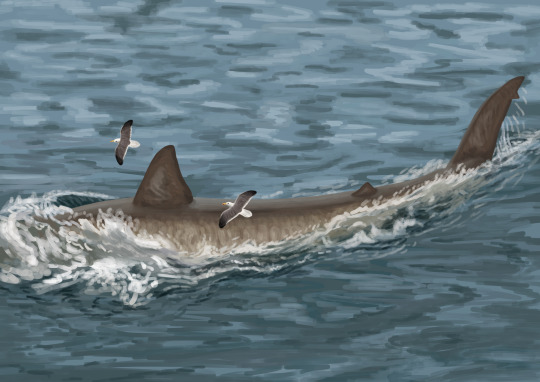
Two gulls follow a weird fish. Featuring the newly elongated Otodus megalodon.
3K notes
·
View notes
Text
The only Megalodon that matters

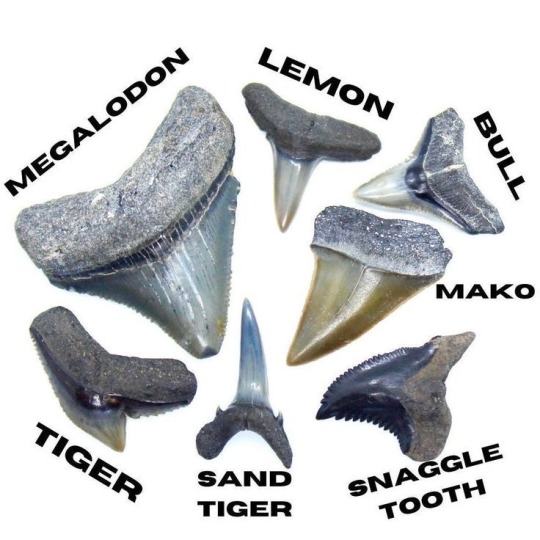
Megladon <3
224 notes
·
View notes
Text

Patreon request for rome.and.stuff (Instagram), and my first plesiosaur (well, first since I was like… 10)
Pliosaurus funkei!
Pliosaurs were a family of plesiosaurs that eventually lost their stereotypical long-necked, small-headed body plan. Resembling the mosasaurs that would come much later, pliosaurs had short necks with large, strong jaws, and fed on fish, cephalopods, and marine reptiles. The type genus, Pliosaurus, contains at least 6 species. The first and type species, P. brachydeirus, was described and named by Sir Richard Owen in 1841.
Between 2004 and 2012, a new species of Pliosaurus was in the process of being uncovered. Before it was formally described or even named, news of this giant sea monster escaped into the general media and it was dubbed “Predator X”.
This Predator X prompted a media frenzy… there were articles estimating its size based on the fragments found so far, a 2009 television special on the History channel, and a segment in the 2011 BBC documentary series “Planet Dinosaur.”
Predator X was reportedly the “most fearsome animal ever to swim in the oceans!”
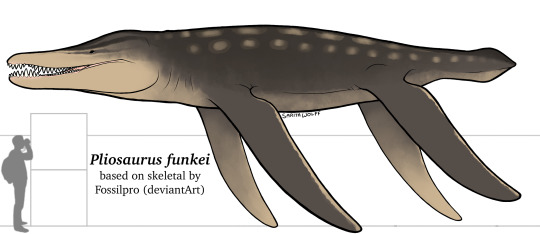
When Pliosaurus funkei was finally formally described and named in 2012, it was found to be a bit smaller than the giant 15 meter long estimate being thrown around. However, it was still a very large animal, around 10–12 m (33–39 ft) long with a 2.0–2.5 m (6.6–8.2 ft) long skull. It also had very long flippers, probably to aid in maneuverability and speed. Analysis of Pliosaurus funkei’s skeleton show that it likely used its front flippers to cruise, only using its back flippers for quick bursts of speed when pursuing prey. Analysis of its brain case shows that its brain was proportional to that of a modern great white shark. So while it didn’t quite beat the Late Cretaceous 12–15.8 meter (39–52 ft) long mosasaur Tylosaurus, the Early Miocene to Late Pliocene 10.5-20.3 meter (34-67 ft) long shark Otodus megalodon, or even the modern day 11-16 meter (36-52 ft) long Physeter macrocephalus (Sperm Whale), it was still no doubt the apex predator of its time and environment.
Pliosaurus funkei lived in the last era of the Late Jurassic in the icy waters of Norway. Found in the Slottsmøya Member of the Agardhfjellet Formation, it would have lived in a cold, shallow sea rife with methane seeps. These methane seeps supported a high amount of diversity, and the Slottsmøya was teeming with ammonites, bivalves, gastropods, brachiopods, tubeworms, echinoderms, cold water sponges, and more. Many icthyosaurs and plesiosaurs would have enjoyed feeding on the plentiful invertebrates here, as well as each other. Pliosaurus funkei would have likely fed on other plesiosaurs like Colymbosaurus, Djupedalia, Ophthalmothule, and Spitrasaurus, as well as icthyosaurs like Cryopterygius, Undorosaurus, Arthropterygius, Nannopterygius, and Brachypterygius.
#my art#SaritaDrawsPalaeo#Pliosaurus funkei#Pliosaurus#pliosaur#predator x#plesiosaurs#sauropterygians#reptiles
83 notes
·
View notes
Text

The gargantuan shark Otodus megalodon, peacefully swims through the Miocene ocean.
#megalodon#paleoart#paleontology#evolution#dinosaur#dinosaurs#animal art#animals#zoology#shark#sharks#miocene#neogene#cenozoic
32 notes
·
View notes
Note
suaropods on earth are the absolute upper limit for land vertebrates, but is it because they have four legs? cause i was working on a scifi spec evo idea where the endoskeletal vertebrate-analogs have eight legs and it got me wondering if it means their sauropod equivalents can be even bigger in a similar earth like gravity
If it was just about leg numbers then land mammals wouldn’t be smaller than the biggest dinosaurs
In reality you need specific evolutionary pressures, circumstances, and unique and efficient anatomy to get big.
For sauropods it was entirely due to their internal anatomy. Sauropods are saurischian dinosaurs, which have hollow bones with internal scaffolding that likely made them stronger than if they were solid, as well as a very extensive respiratory system that included numerous air sacks, many of which ran through their bones. This ultimately allowed saurischian dinosaurs to massively cut back on volume and allow them to cool off easier and have more efficient respiration. There’s things we still don’t know about sauropod anatomy though such as how their circulatory systems combated their sheer verticality. Dinosaurs also have unidirectional respiratory systems, which is more efficient than mammalian two way airflow.
For modern baleen whales it has more to do with the aftermath of the last ice age and how it impacted the location of their food (keep in mind this explanation of the evolution of baleen whale size is based on my current understanding and might not be correct). Baleen whales actually used to be much smaller, around bus size. But during and after the last ice age the ocean currents changed and krill populations became concentrated around the poles. Because of this, baleen whales needed a way to eat as much as possible in one sitting and travel long distances efficiently. The easy solution was to get big, which became easier as their predators the macroraptorial sperm whales and Otodus megalodon gradually went extinct. A thing to note however, is that because they need more resources due to their size, the number of baleen whale species is lower than it was several million years ago. Also also, blue whales are getting bigger.
On earth, 200 tons is more or less the maximum size for animals, as the biggest whales, ichthyosaurs, and sauropods got around that size.
There’s more things to note though:
No, higher oxygen levels don’t make things bigger. Not even bugs. Modern arthropods are actually on average bigger than their Carboniferous counterparts, and the oxygen levels were way higher back then. And griffinflies, very active flying insects, lasted all the way into the Permian, when oxygen levels were lower than in modern day.
It’s important to consider what the bones of animals are made of as well as their structure. Different internal structures can handle stress better, and different materials can handle pressure differently.
Eight legs might be too many, as having more legs, while very stable, can be more energy costly. Two legs might not be able to support as much weight as four, but it is more efficient.
A very big thing animals have to fight with when it comes to size is something called the square cube law. Basically as something gets bigger its volume (insides) increase way faster than its outsides (surface area). If you had a 1 centimeter cube and doubled its size, the surface area would quadruple but the insides would increase eight times. But there are ways of combating this such as decreasing volume with things like air sacks or increasing surface area by being very wrinkly (that’s how human brains fit so many neurons!). And because things with a metabolism generate heat, big animals have to combat overheating because they have a lot of insides. That’s why elephants have such big vascularized ears and why their skin acts like a sponge to soak up water.
Also I have no idea how perucetus got so big, that glorious fatass
#ask#questions#anon#anonymous#biology#paleontology#palaeoblr#speculative evolution#speculative biology#speculative anatomy#speculative zoology
188 notes
·
View notes
Text

“In the course of twenty million years, mammals got more and more successful until they were the biggest, fiercest, and most spectacular animals on the planet. Whatever the climate, whatever the habitat, mammals made it their own. Their great strength was their ability to adapt. They grew to gigantic sizes, they evolved into powerful killers like the famous sabre-tooth cats, and they even laid claim to the oceans.”
- Kenneth Branagh, prologue to “Walking with Beasts”
Sketches of some of the incredible wildlife of the Cenozoic Era. None of the animals are exactly shown to scale. From left to right, bottom to top:
Arctocyon, Barylambda, Coryphodon, Titanoboa
Uintatherium, Notharctus, Mesonyx, Eobasileus
Leptictidium, Gastornis, Propaleotherium, Titanomyra, Godinotia, Pakicetus, Ambulocetus
Apidium, Arsinotitherium, Andrewsarchus, Embolotherium, Moeritherium, Dorudon, Basilosaurus, Perucetus
Megacerops, Cainotherium, Merycoidodon
Cynodictis, Paraceratherium, Hyaenodon gigas, Chalicotherium, Paraentelodon
Gentilicamelus, Amphicyon, Daeodon, Moropus, Dinocrocuta, Platybelodon, Gomphotherium, Pelagornis, Purussasaurus, Odobenoceratops, Otodus megalodon
Phoruschracos, Astrapotherium, Teleoceras, Synthetoceras, Samotherium, Livyatan
Australopithecus afarensis, Deinotherium, Ancylotherium, Dinofelis
Mammuthus columbi, Smilodon fatalis, Bison latifrons, Aenocyon dirus, Arctodus simus, Panthera atrox, Titanotylopus, Equus hersternus, Sivatherium, Gigantopithecus, Paleoloxodon
Smilodon populator, Macrauchenia, Doedicurus, Megatherium, Glyptodon, Toxodon
Mammuthus primigenius, Megaloceros giganteus, Coelodonta antiquitatis, Bos primigenius, Homo neanderthalensis, Elasmotherium, Bison bonasus
#paleoart#paleontology#cenozoic mammal#cenozoic animals#cenozoic mammals#cenozoic era#cenozoology#cenozoic#palaeontology#paleoartist#artists on tumblr#paleoartists on tumblr#paleoblr#paleogene#neogene#quaternary#paleocene#eocene#oligocene#miocene#pliocene#pleistocene#palaeoart#paleo#palaeoblr#paleoillustration
53 notes
·
View notes
Text


Aaaand all The Divers are done!
Born just over a year after the second litter, these two are the baby brothers of the group and mark the final of Otodus' litters.
Otodus planned to have another litter following, but contracted feline panleukopenia virus over halfway through pregnancy and became gravely ill. She ended up being taken by the owners of her partner at the time, Roman, upon his pleading for her to go to the vet, leaving The Hammerhead Shark as the de facto leader for two and a half moons. She was treated, then later spayed, and kept confined to the owner's nest for recovery. She returned one day without explanation with her two young kits in toe. Roman was not in company. The circumstances of these two's births is a sore topic amidst The Divers, Otodus becoming quick to anger if there is any reference to Roman or her sickness & recovery. Any facts within are ancient history.
The Nurse Shark has a dynamic range of expertise, usually growing bored of his job roles and squeezing into another when he gets the chance. He has some medical and craft knowledge, but currently (and with the greatest longevity) has taken to food preparation and cooking for the group. While he knows how, he isn't confident swimming, preferring to stick to the shore or boats built by the group. He's probably the most "normal" of The Divers, although that's not saying much…
and The Great White Shark. My main guy. Debatably the WORST of The Divers. A violent asshole who sees the world as his playground, he's honestly just here for a good time. But his use to the group with strength, hunting and aquatic prowess are undeniable. Most of his siblings are at least somewhat uneasy around him, and for good reason.
DIRECTORY:
[Captain Otodus]
[Otodus' First Litter]
[Otodus' Second Litter]
[Otodus' Third Litter]
#// long post#// sickness#// pregnancy#// ask to tag#cheez rambles#cheez design#my art#original character#warriors oc#By Sand By Sea#The Divers#The Nurse Shark#The Great White Shark#Captain Otodus#The Megalodon#// yes i just traced the line around White Shark's old ref bc I still like it enough to use it#// Literally no one: + Nurse: cooking in the kitchen!!!
98 notes
·
View notes